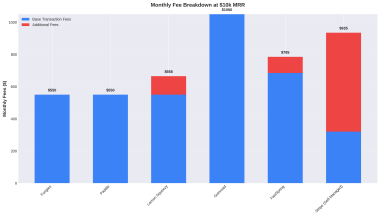Learn about software gross margin, its importance, and how to improve it for your SaaS business. Enhance profitability and attract investors with key strategies.
Do you wish you had a clearer idea of how well your company is doing financially? If you want to make your software more profitable and attract investors, you need to understand the software gross margin.
Software gross margin shows how much profit your company makes from its software products. It’s a key metric for understanding your company’s financial health and efficiency. By tracking gross margin, you can see how well you’re managing costs and making profits.
In this article, we will explore what software gross margin is, why it matters, and how it can impact your business decisions.
What is Software Gross Margin?
Imagine you run a lemonade stand. You buy lemons, sugar, and cups to make lemonade. Software Gross Margin is like the money you have left after buying all these supplies and selling your lemonade.
In the world of computers, companies sell software. Software Gross Margin is a way to measure how much money a software company makes after paying for the things they need to create the software. The lower the cost, the higher the gross margin, which is generally good for the business.
Why is it important?
Think of your lemonade stand again. If you spend most of your money on supplies, you won’t have much left over. This is similar to a software company with a low gross margin. A high gross margin shows that a company is good at making money. Beacuse they are spending less on creating their software than they are earning by selling it.
Investors who give money to software companies like to see a high gross margin. This is because it shows the company is good at managing their money and is likely to be profitable in the future.
Here are some key points to remember about Software Gross Margin:
- It’s a measurement of a company’s profit after paying for what they need to make their software.
- A high gross margin is generally good for a business.
- Investors consider gross margin when deciding whether to invest in a company.
How to Calculate Software Gross Margin?
To determine the gross margin for a SaaS business, you use a straightforward formula:
The formula for Gross Margin: Gross Margin = (Revenue – Cost of Goods Sold) / Revenue.
This formula helps understand how much of each dollar of revenue a company retain. After accounting for the direct costs associated with delivering its services.
Basic Calculation of Gross Margin
Example 1: Company A Let’s consider Company A, which has:
- Revenue: $1,000,000
- Cost of Goods Sold (COGS): $300,000
Calculation: Gross Margin = ($1,000,000 – $300,000) / $1,000,000 Gross Margin = $700,000 / $1,000,000 Gross Margin = 0.70 or 70%
This means Company A retains 70 cents for every dollar of revenue after accounting for the costs.
Example 2: Company B Now, let’s look at Company B:
- Revenue: $2,000,000
- COGS: $600,000
Calculation: Gross Margin = ($2,000,000 – $600,000) / $2,000,000 Gross Margin = $1,400,000 / $2,000,000 Gross Margin = 0.70 or 70%
Similarly, Company B also has a gross margin of 70%, indicating it retains 70 cents of every dollar in revenue after accounting for direct costs.
Why is Gross Margin Important for SaaS Business?
Understanding gross margin is crucial for SaaS businesses. Here’s why:
Financial Health and Profitability
Gross margin shows how profitable a SaaS business is. It reflects the difference between revenue and the cost of delivering services. A higher gross margin means the company is keeping more money from each dollar of sales. This indicates that the business is profitable and managing its costs well.
Operational Efficiency
Gross margin helps measure how efficiently a company manages its costs. By analyzing this metric, businesses can see if they are spending too much on delivering their services. A high gross margin suggests that the company is operating efficiently. This means it can control its costs while still delivering high-quality services.
Cash Flow Management
Gross margin impacts cash flow and financial stability. A healthy gross margin ensures that the company has enough money to cover its operating expenses. This is crucial for maintaining day-to-day operations and planning for future growth. A stable cash flow allows the business to invest in new projects and improve its services.
Investment Decisions
Gross margin plays a significant role in investment decisions. Investors look at this metric to assess the financial health of a company. A high gross margin signals a strong and sustainable business model. This attracts investors and influences their decisions on funding and partnerships. It shows that the company can generate steady profits and has potential for growth.
Tools like Fungies.io can be very helpful for SaaS businesses aiming to optimize their gross margin. Fungies streamlines billing processes and enhances profitability naturally. By using such tools, companies can improve their operational efficiency and maintain a healthy gross margin.
Understanding and managing gross margin is essential for SaaS businesses. It ensures profitability, sustains growth and attracts investment.
Ways SaaS Companies Can Improve Gross Margin?
Expand Accounts and Markets
Upselling and Cross-selling
Upselling means offering additional products or upgrades to existing customers. For example, if a customer has a basic plan, you can offer a premium plan with more features. Cross-selling involves suggesting related products. For instance, if a customer buys a software package, you can recommend an add-on that complements it.
Freemium to Paid
Many SaaS companies offer a free version of their product to attract users. Once users see the value, they can convert to paid accounts. This strategy helps in increasing revenue without high additional costs.
Microservices
Microservices are small, separate services that meet specific needs. Offering these services can meet additional needs of current customers. For example, a company might offer Dealhub CPQ along with DealRoom and Billing services.
Feature Add-ons
Providing additional features that customers can purchase helps in increasing revenue. These could be upper-tier features accessible to all or new paid features that solve specific problems.
Expanding into New Markets
Reaching new customer segments is another way to grow. If your product works well with a particular group, try to expand to similar groups. Adjust your sales and marketing strategies to attract these new customers.
Reduce Costs
Outsourcing Services
Outsourcing customer support or development can reduce costs. However, it’s important to maintain quality. This approach works well for startups on a tight budget but might not support a growing customer base in the long run.
Internal Process Efficiency
Improving internal processes can save money. Look for ways to streamline operations and automate tasks. Adopting agile development approaches like continuous integration or delivery can also help. Implementing a DevOps mindset, which focuses on collaboration between software developers and IT teams, can improve efficiency.
Product Efficiency
Invest in making your product more efficient. The fewer resources it takes to run and maintain, the lower your costs. This allows you to focus more on development and less on maintenance.
Optimize Pricing
Market Research
Analyzing competitors’ pricing helps you understand the market. Survey your customers to see how much they are willing to pay. This helps in setting the right price.
Differential Pricing
Use differential pricing to charge different prices for different segments. However, avoid varying prices based on incorrect parameters. Make sure the pricing strategy is fair and makes sense.
Avoid A/B Testing Prices
Avoid A/B testing your prices as it can frustrate customers who end up paying more. Instead, rely on market research and customer feedback.
Examine Payment Structure
Annual Prepayment Discounts
Offering discounts for annual prepayment can improve margins and customer retention. While customers might get a discount, it ensures they stay with you for a year.
Explore Marketing Channels
Multi-Channel Sales Approach
Using various marketing channels helps reach a wider audience. Some effective channels include:
- Social media marketing
- Content marketing
- Influencer marketing
- Email marketing
- Referral programs
Each channel has its own advantages. Combining them can maximize your reach.
Analyze and Reduce Customer Acquisition Costs
Effective Strategies
Lowering customer acquisition costs improves profitability. Some strategies include:
- Word-of-mouth marketing
- Search engine optimization (SEO)
- Channel sales
- Partnerships
Reducing these costs helps in improving overall profitability.
Leverage a Revenue Tech Stack
Automation and Efficiency Tools
Using tools like CPQ, billing systems, contract management, and revenue analytics can reduce costs and increase efficiency. Fungies.io, for instance, can help streamline billing processes and boost efficiency. This leads to a higher gross margin for your SaaS company.
By following these strategies, SaaS companies can improve their gross margins and ensure success.
Do Investors or VCs Look at Gross Margin?
Investors and venture capitalists (VCs) pay close attention to gross margin. Here’s why:
Investor Perspective on Gross Margin
Gross margin is a key metric for investors. It shows a company’s profit after subtracting the cost of delivering its services. A high gross margin means the company is profitable and manages its costs well. This is important because it indicates the company’s ability to sustain itself and grow.
Importance in Investment Decisions
Investors prioritize gross margin in their decisions. A high gross margin signals a strong business model. It shows that the company can generate steady profits. This makes the company attractive for investment. Investors want to put their money into businesses that can deliver good returns with low risk.
Benchmarking Against Industry Standards
Investors compare a company’s gross margin to industry standards. This helps them see how well the company is performing relative to its competitors. A higher than average gross margin indicates that the company is more efficient and profitable than others in the industry. This comparison helps investors assess the company’s competitive edge and market position.
Milestones for Gross Margin at Different Stages of SaaS Business
Gross margin milestones are important for SaaS businesses at different stages of growth. Let’s look at these milestones in more detail:
Early Stage Milestones
At the early stage, SaaS companies aim to achieve a gross margin of 60%. This shows that the company is managing its costs well while delivering its services. A 60% gross margin means the company is keeping a good portion of its revenue as profit.
Example 1: Company C Company C achieved a 60% gross margin in its early stage. They focused on controlling costs and delivering high-quality services. This strong start helped them build a solid foundation for future growth.
Growth Stage Milestones
During the growth stage, companies aim for a higher gross margin of around 70%. This indicates that the company is scaling its operations efficiently. A 70% gross margin shows that the company can handle increased demand while maintaining profitability.
Example 2: Company D Company D maintained a 70% gross margin during its rapid growth phase. By optimizing processes and leveraging economies of scale. They managed to keep costs low while expanding their customer base. This allowed them to grow quickly and sustain their profitability.
Mature Stage Milestones
In the mature stage, SaaS businesses aim for an even higher gross margin of 80%. This high margin indicates that the company is very efficient and has a strong market position. An 80% gross margin means the company is generating substantial profits from its revenue.
Example 3: Company E Company E sustained an 80% gross margin in the mature stage. They achieved this by continuously improving their operations and expanding their product offerings. This high margin allowed them to invest in new innovations and stay ahead in the market.
High Gross Margin SaaS Businesses in Public Market
Understanding how top SaaS companies achieve high gross margins can provide valuable insights. Let’s look at some benchmark examples:
Salesforce
Salesforce is known for its high gross margin performance in the stock market. They focus on cloud-based CRM solutions. By optimizing their operations and managing costs, Salesforce consistently maintains high gross margins. This efficiency helps them generate substantial profits and stay competitive.
Adobe
Adobe has maintained strong gross margins over time. They offer digital media and marketing software through subscription-based models. By continuously innovating and improving their products, Adobe ensures high customer satisfaction. This approach helps them keep their gross margins high and profits steady.
ServiceNow
ServiceNow provides a cloud-based platform for enterprise IT services. They have a successful gross margin strategy. By automating workflows and enhancing productivity, ServiceNow achieves high gross margins. This strategy allows them to scale efficiently and generate consistent returns for investors.
Final Thoughts
Knowing your software gross margin allows you to manage costs and boost revenue effectively. It plays a vital role in attracting investors and ensuring business sustainability. As you optimize your gross margin, consider using tools like Fungies.io to streamline your operational processes.
Stay informed and proactive about your software gross margin. This will help your SaaS business thrive in a competitive market.






